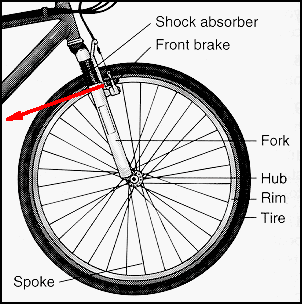|
Bicycle
brakes are designed to apply a moment to a rotating wheel and to decrease
its rotational rate. The brake pads of the calliper brake shown in the
diagram produce a normal force, N, on the wheel rim a distance, r, from
the axle. There is a friction interaction between the rim and the pad which
produces a force mN
in the direction shown by the red arrow. This tangential force produces
a moment mNr
about the wheel axle which reduces the angular momentum of the wheel.
If
the bike were on a stand and the wheel was free to rotate, it would have
an angular momentum, Iw,
at an angular velocity w, where
I is the moment of inertia of the wheel. If the brake is applied for a
time, t, the angular velocity of the wheel will change from w0
to wt
and the corresponding change in the angular momentum is related to the
moment of the tangential force and the time for which it is applied by
the expression: I(
w0
- wt)
= mNrt.
The rotational kinetic energy of the wheel also changes during this process
and this change is related to the moment acting on the wheel and the total
number of radians, q,
the wheel rotates in the time t: mNrq
= I(w02
- wt2)/2. |
|
|
|
|
|
|
|
|
|
|
|
|
